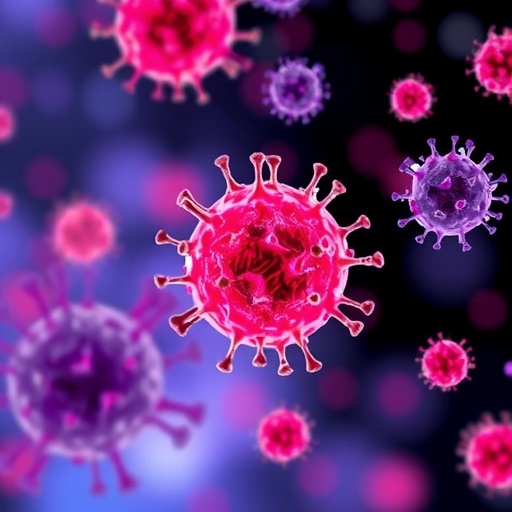In a breakthrough study that may revolutionize cancer treatment paradigms, researchers at Cincinnati Children’s have uncovered a critical genetic mutation responsible for the resistance of certain tumors to immune checkpoint inhibitors (ICIs), a transformative class of immunotherapies. This discovery sheds light on the molecular underpinnings that render specific cancers unresponsive to ICIs, offering new hope through a repurposed drug, rapamycin, which may restore treatment sensitivity and dramatically improve patient outcomes.
Immune checkpoint inhibitors have emerged over the past decade and a half as a game-changing treatment for advanced metastatic cancers, enabling durable remissions in many patients by unleashing the immune system to attack tumors. However, despite their promise, a significant subset of tumors remain immunologically “cold”—immune evasive and unresponsive to these therapies. This cold tumor microenvironment represents a formidable barrier to effective immune-mediated tumor eradication and has puzzled researchers striving to understand the mechanisms of resistance.
The team from Cincinnati Children’s, led by PhD Yi Zheng and graduate student Mingjun Cai, focused their investigation on a mutation in the gene RAC1, specifically the A159V variant. Using murine models and a combination of experimental techniques, they demonstrated that this mutation accelerates tumor growth across multiple cancer types, including colon, lung, head and neck cancers, and melanoma, while simultaneously creating an environment hostile to immune infiltration and attack. This discovery was published in the journal Science Advances in October 2025.
The RAC1 A159V mutation was found to orchestrate a hostile tumor microenvironment by activating mTORC1 signaling pathways. This activation results in markedly increased tumor cell glucose uptake. Consequently, immune cells, starved of vital energy substrates, become incapacitated in their ability to mount an effective anti-tumor response. Additionally, the mutation dampens production of chemokines—crucial molecular signals that recruit immune cells—and suppresses expression of IFNGR1, a receptor essential for interferon gamma-mediated immune activation. Together, these molecular events solidify an immunosuppressive milieu that shields tumors from immune checkpoint blockade.
Remarkably, the researchers demonstrated that rapamycin, a well-known mTORC1 inhibitor approved by the FDA and commonly used as an immunosuppressant to prevent organ transplant rejection, can reverse these resistance mechanisms when administered alongside immune checkpoint inhibitors. In multiple experimental tumor models harboring the RAC1 A159V mutation, this combination restored sensitivity to ICIs, enabling robust immune infiltration and tumor regression comparable to that seen in non-mutant tumors.
The implications of these findings are profound. Immune checkpoint inhibitors function by disabling the cancer cells’ exploitation of immune “checkpoints” that normally restrain immune activity, effectively unleashing T cells to attack malignant cells. However, the efficacy of ICIs is limited when tumors employ alternate mechanisms to evade immune recognition and destruction. By identifying the RAC1 A159V mutation as a driver of such evasion and pinpointing rapamycin as an agent to overcome it, this study opens new avenues for therapeutic intervention tailored to genetic subtypes of resistant cancers.
This discovery also introduces a potential paradigm shift in patient stratification. Although the RAC1 A159V mutation likely exists in only a subset of cancers presently classified as immunologically cold, its detection could inform clinicians about the suitability of adding mTORC1 inhibition to existing checkpoint blockade regimens. This stratified approach may maximize therapeutic responses while minimizing unnecessary exposure to additional drugs and their potential side effects.
Notably, the beneficial effects of rapamycin in this context appear achievable at low doses, which may substantially mitigate the risks associated with immune suppression, a key consideration given rapamycin’s traditional clinical use to prevent graft rejection. Dr. Zheng emphasized that this low-dose approach could offer a manageable safety profile, fostering its integration into combination immunotherapy protocols for patients with RAC1-mutated tumors.
Despite these exciting developments, the authors acknowledge that extensive clinical validation remains necessary. The current results are based on animal tissue models, and translation to human cancers will require carefully designed clinical trials that confirm both efficacy and safety in patients. Such studies are anticipated to span several years and will be pivotal in determining the clinical utility of combining rapamycin with ICIs in cancers bearing the RAC1 A159V mutation.
The research also invites further medicinal chemistry efforts aimed at developing novel, more selective inhibitors of RAC1 signaling. Such agents could potentially harness the beneficial immunomodulatory effects identified in this study while minimizing broad immune suppression, thus enhancing therapeutic precision and patient tolerability.
In sum, this pioneering investigation has illuminated a crucial genetic mechanism driving immune evasion in cancer and established a scientifically grounded, actionable strategy to counteract it. It significantly advances our understanding of tumor-immune system interactions, heralding a new chapter in the pursuit of more effective, genetically informed immunotherapies.
Moving forward, the Cincinnati Children’s team, supported by facilities specializing in flow cytometry, single-cell genomics, and genomic sequencing, is poised to expand this foundational work. Comprehensive analyses in human tissues, coupled with future clinical trials, will determine how these insights can be translated into transformative treatments for cancer patients worldwide.
Ultimately, this study exemplifies the power of integrative research at the intersection of molecular biology and immunotherapy, offering tangible prospects for overcoming one of the most challenging hurdles in oncology: the resistance of cold tumors to immune checkpoint inhibition.
Subject of Research: Animal tissue samples
Article Title: Tumor-derived RAC1A159V mutation promotes an immunosuppressive microenvironment that represses response to immune checkpoint inhibitor
News Publication Date: 29-Oct-2025
Web References: https://doi.org/10.1126/sciadv.aea1212
Image Credits: Cincinnati Children’s
Keywords: Health and medicine, Cancer




